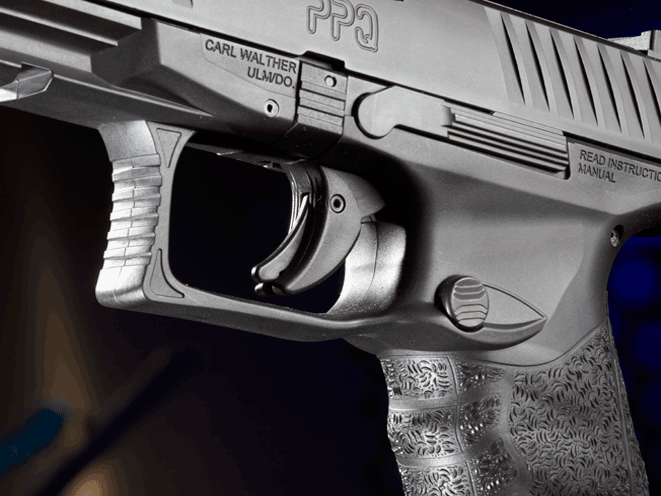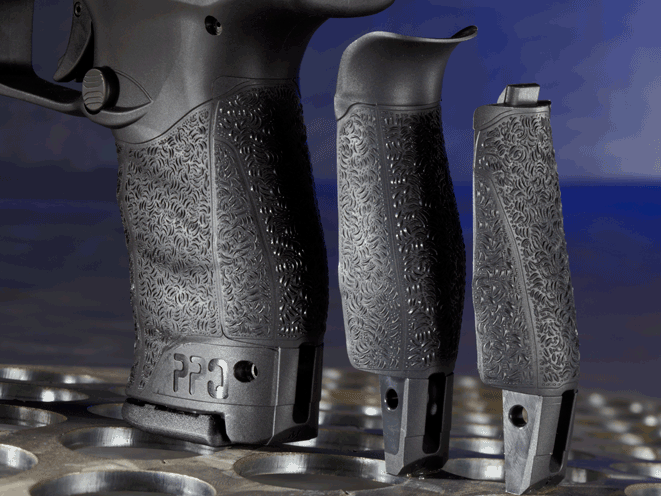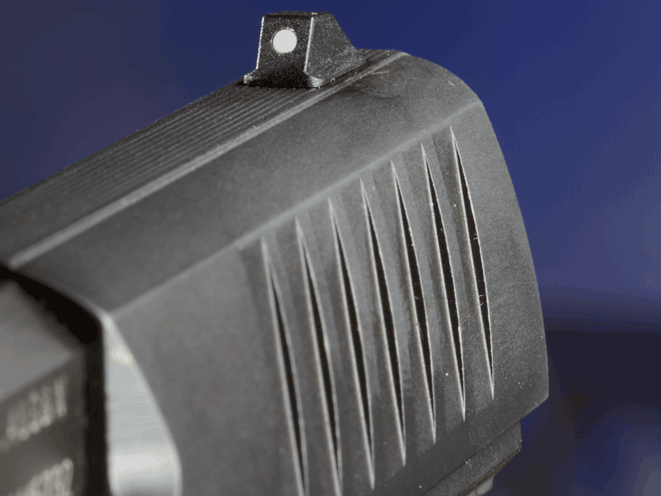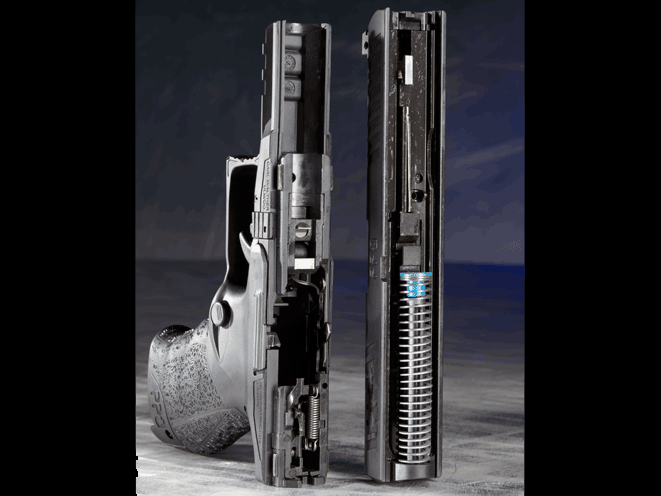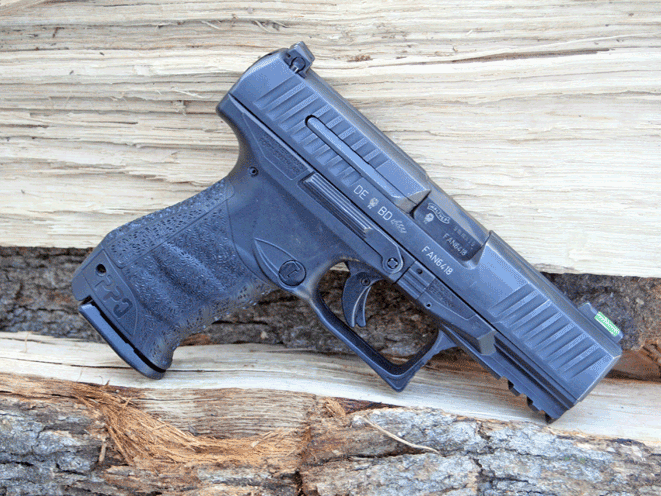Walther has been synonymous with quality workmanship and classy firearms longer than any of us have been alive. The company’s American face has morphed over the years, including Interarms and Smith & Wesson. Walther’s partnership with S&W ended recently, though on amicable terms; S&W is still manufacturing Walther PPK pistols sold in the U.S. at its Houlton, Maine, factory. However, Walther is conjoined with Umarex, a leading manufacturer of air guns, and that company’s plant in Fort Smith, Arkansas, is the new headquarters of what might generically be called “Walther USA,” though the company doesn’t use that term. I suspect it’s only a matter of time before Walther pistols are manufactured at that 27-acre facility.
That location is now the service headquarters for Walther firearms in this country. Touring the plant, I was impressed with the impeccable cleanliness, and got a strong sense that the employees enjoyed working there. Nowhere was that truer than in the service department, where records showed that some 94 percent of Walthers sent in for service were fixed and on their way back to their owners in 48 hours. That’s impressive.
Adam Blalock, who heads the U.S. arm of Walther, was a gracious host. He wanted to make sure we got a chance to shoot the gun he considers the flagship of the current Walther pistol line, the “Americanized” PPQ M2. We did, and here’s the story.
Advertisement — Continue Reading Below
Design History
In the course of researching this article, I picked up the splendid two-volume set of coffee-table books titled Walther: A German Success Story, written by Manfred Kersten, Dr. David Schiller and Ulrich Eichstadt and edited by Wulf-Heiz Pflaumer and Franz Wonisch. Volume 2 has the following to say about the background of the PPQ series:
Advertisement — Continue Reading Below
RELATED: Covert Walther Pistols
“Law enforcement and the military have their own unique requirements regarding their choice of service weapons. This awareness gradually impacted officials, procurement personnel and manufacturers and was eventually incorporated into weapon designs and production. Early on, Walther technicians in Germany encountered a problem; specifically, the certification of service weapons in accordance with the regulations of the TR Technical Guidelines (Technische Richtlinie). Their solution was to design a pistol with trigger values below the regulations of the TR. They accomplished this just prior to the IWA in 2011. The new ‘PPQ’ was ready in time to be introduced to the experts, and the response was enthusiastic. The new Walther Defense catalogue, published in March 2011 for the IWA show in Nuremberg, celebrated the PPQ as the flagship of the entire service weapon program, devoting 12 of a total of 27 pages to the PPQ. The PPQ version differed externally from the other successors of the P99 series. Its dimensions and weight were identical to the previous versions. The frame had a new surface material called ‘Hi-Grip.’ The front and rear serrations on the slide were cut larger in order to afford a better grip to the fingers, even when gloves were being worn. In contrast, the slightly slanted and tapered side of the muzzle area of the housing, and the continuing horizontal lines of the QA and AS (variations of the P99) were omitted. The decocking lever was also omitted.”
This original version of the PPQ featured an ambidextrous, double-paddle magazine release riding along the bottom edge of the triggerguard on each side. It was operated by pressing down with the trigger finger. This same system is found on the flat, subcompact Walther PPS, which has become quite popular in the U.S.
Advertisement — Continue Reading Below
An ingenious approach to the dumping of empty magazines, this can also be very fast with practice. However, since about 1911, Americans have been habituated to releasing a pistol magazine by pressing inward on a button usually located on the left side of the frame behind the trigger. As efficient as it might have been, the lever on the original PPQ’s triggerguard just wasn’t intuitive for American shooters, and it turned a lot of them off on the new pistol. Walther picked up on that, and the cardinal difference between the original PPQ and the PPQ M2 we’re about to discuss is that the latter has a push-button mag release located in what we Yanks consider to be “the right place.”
Gun Details
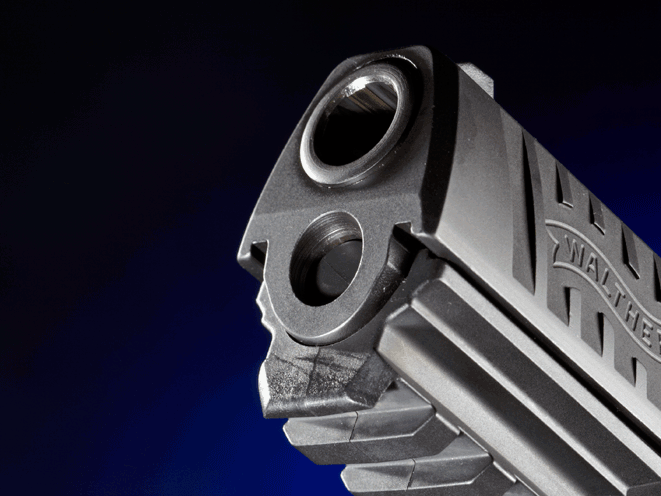
A signature feature on modern polymer-frame Walther service pistols is modular backstraps to adjust for hand size. As I recall, Walther began this trend, and most of its competitors have followed suit. My PPQ M2 test gun came with small, medium and large backstraps. They’re shaped to give the shooter options when it comes to adjusting the grip’s girth and angle. I tried all three backstraps, and in my average-size hand, the smallest size fit the best. That’s what I kept on the pistol for the remainder of the test.
Advertisement — Continue Reading Below
RELATED: Walther’s CCP Concealed Carry 9mm Pistol
Much has been said about the PPQ’s trigger pull. The trigger itself has a Glock-ish look, but the pull is not quite the same. Here’s what Volume 2 of that cool Walther book has to say about it: “The most important special feature of the PPQ is the improved trigger system: The pre-cocked firing pin lock releases at a pressure of 25 newtons due to its very crisp and short trigger travel. The trigger travel is 0.197 inches (5mm) and the release travel is only 0.039 inches (1mm). In order to release the next shot, the shooter only needs to let the trigger back 0.098 inches (2.5mm). All combined, this allows for quick ‘double-tap’ shots and improves the rate of fire during combat shooting.”
My colleague Jon Hodoway weighed the test gun’s trigger pull on my Lyman digital gauge from Brownells. Measuring at the toe of the trigger—the greatest leverage point, which seems to be the industry standard of pull weight measurement, but is not where most human hands end up on triggers—he found an average of 4.96 pounds. At the center of the trigger, where the shooter’s finger generally winds up, he recorded an average pull weight of 4.69 pounds. This is less difference than I usually see when pivoting triggers such as the PPQ’s are measured both ways. The “25 newtons” quoted earlier translates to 5.62 pounds.
Advertisement — Continue Reading Below
My test sample had a lot of creep in the take-up but was sweet for the rest of the pull. The drag was less noticeable the faster we shot it and, of course, if the shooter was to “ride the link” just far enough to reset, that creep was not present at all. There was no readily noticeable “trigger backlash,” always a good thing.
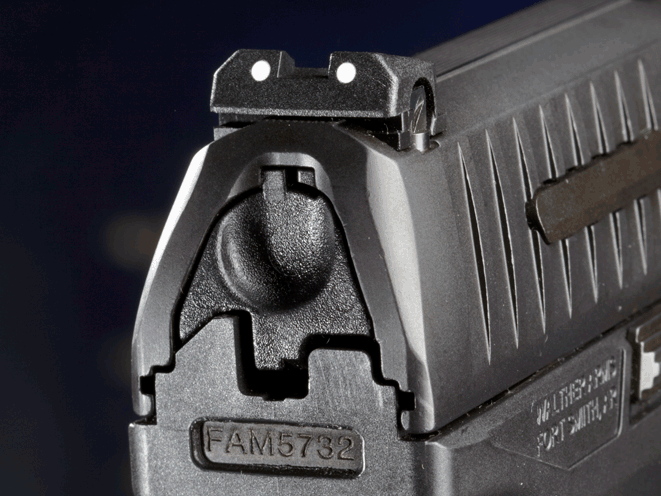
We also noted that the magazine release spring was very light. This encouraged positive magazine ejection. I had feared that it might release accidentally, especially with a low thumb hold, but this never occurred in our testing, though I’ve experienced that with the PPX, the PPQ’s hammer-fired lookalike, which has a similar mag release and fills the “economy gun” niche in the current Walther lineup.
The PPQ M2’s sights were interesting. The rear sight is adjustable for windage only, and the front is adjustable for elevation via a replacement post. Be sure yours is steel, not plastic; I got the steel front sight with a green fiber-optic insert, and it provided an excellent sight picture. Replacing the front sight is easy: Take off the slide, undo the old one from under the top of the slide, and insert and tighten the replacement.
Advertisement — Continue Reading Below
A unique feature of the PPQ M2 is a long, flat, ambidextrous slide stop/slide release lever. This made it very fast to close the slide during an “emergency reload,” and was easier to manipulate for south-paws as well as right-handed shooters.
Range Time
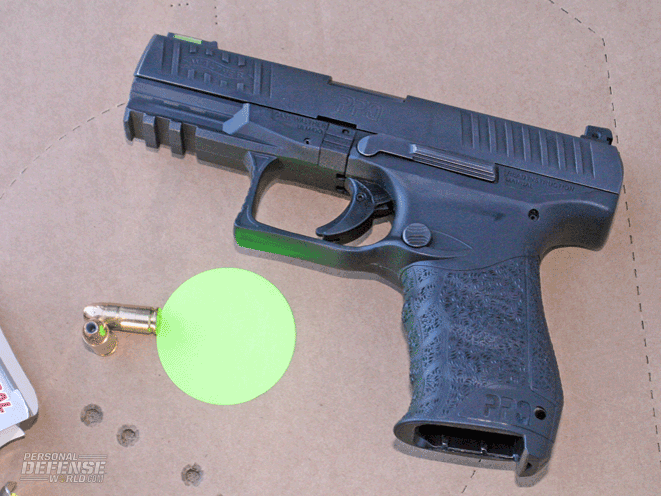
We tested the PPQ M2 off sandbags on a table set at 25 yards at one of the many shooting bays at the Nighthawk Custom Training Academy in Centerton, Arkansas. Three brands of ammunition were used, with bullet weights ranging from 115 to 147 grains. With me was Jon Hodoway, the champion pistol shooter who is the director of training there. We took turns testing the pistol’s accuracy.
Advertisement — Continue Reading Below
RELATED: Walther PPQ M2 5-Inch and PPQ .22 Pistol – New for 2014 | VIDEO
Winchester’s 147-grain Super-X (with lead-free WinClean primers) was the chosen subsonic load. I’ve seen it shoot some fantastic groups in match-grade 9mm pistols. Out of the PPQ M2, it gave Jon a five-shot group that measured 4.38 inches. The best three of those were 2.75 inches apart. This was the best group either of us could get with that load. For both of us, this ammunition shot 4 to 5 inches above point of aim at 25 yards.
America’s most popular 9mm practice and training load tends to be the 115-grain FMJ. We chose Remington UMC 115-grain FMJs to represent this genre. The PPQ punched five of them into 4.38 inches for Jon, identical to the 147-grain Winchester. The best three snuggled a little tighter, however, at 1.88 inches. This 115-grain Remington ammunition centered around point of aim for elevation.
Advertisement — Continue Reading Below
Finally, to represent a carry load, we tried Federal’s 115-grain jacketed hollow point, the company’s always-accurate 9BP load. This round has often been the most accurate in 9mm pistols I’ve tested over the decades, and it continued the tradition with the PPQ M2, producing a five-shot group of 2.38 inches. The best three of those created a 1.44-inch group. Over many, many years this load has also proven to be a surprisingly good “man-stopper” for a standard-pressure 9mm. Out of this particular gun, this round grouped slightly low and left.
Daily Carry
I carried the sample 9mm PPQ M2 as a teaching gun in a carbon-fiber Concealment Solutions scabbard through four 10-hour days of a MAG-40 class and most of the five 8-hour days of an immediately subsequent MAG-80. There were no surprises and no discomfort. Since a Walther P99 dummy gun fit fine in the holster made for the PPQ, I wouldn’t be at all surprised if a PPQ fit perfectly in a P99 holster if the user couldn’t find a holster marked and sized for the new gun. I was happy with the gun and holster in terms of comfort, speed and concealment. The PPQ came quickly to hand, pointed naturally out of the holster and had no sharp edges to bite the body.
RELATED: Walther PPX 9mm
In initial off-hand shooting, the test pistol shot spot on to the sights with 115-grain range loads. When I shot the pace-setter qualification of the MAG-40 to demonstrate to students what was expected of them, I was using 147-grain subsonic ammo that I hadn’t benched yet. I didn’t notice until we got back to
the 15-yardline that my shots had started to drift high, and wound up two points down on score. My fault; not the gun’s. The gun itself shot fine, delivering the tightest group of 40-some shooters that day. The group was just a bit off of where it should have been, and that responsibility is entirely on the shooter, not the Walther pistol.
During the qualification, the reloads went smooth. While I was aware of some trigger creep at the front end of the pull, I didn’t really feel it affected trigger control or its ability to group. I was aware that the muzzle was rising higher than some of the other polymer 9mm pistols I use, but the sights were still quickly back on target. The bore axis of the PPQ is distinctly higher than that of, say, a Glock.
During that time in Arkansas, we put way over 1,000 rounds of assorted 9mm ammunition through an assortment of standard-size PPQ M2 pistols. I didn’t see or experience or even hear of a single malfunction. That included two students in the MAG-40 class who brought their own PPQ M2s and sailed through the 500 rounds with no malfunctions.
Final Notes
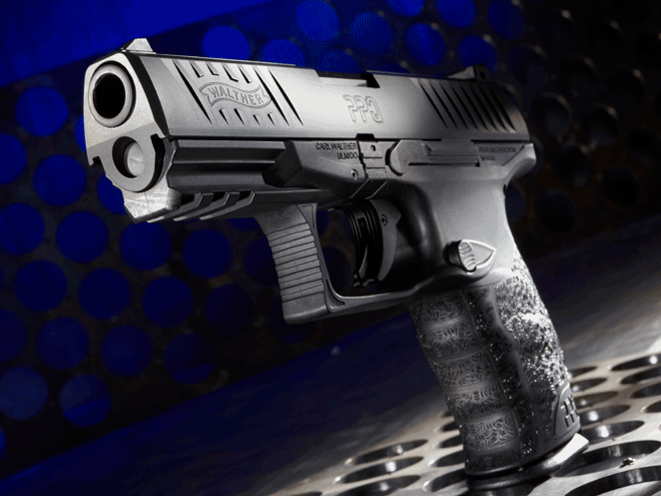
I liked the way this pistol carried and “came to the hand.” I can’t fault its “shootability.” I’m not the only one who has noticed it does not seem to do its best with 147-grain 9mm ammunition in terms of accuracy. It was designed in Europe, remember, and the 147-grain subsonic 9mm round is very much an American taste.
While the relatively high bore axis did result in a palpable, visible increase in muzzle rise, it was no problem shooting at police qualification speed. I want to work with this gun a little bit more, and by the time you read this I’ll have one in my armory to do just that.
I learned to like this pistol. The PPQ M2 has a lot going for it. At a price of $599, it’s quite competitive with the other big-name polymer service pistols on the market. Ten-round magazines are available in both 9mm and .40 for those who live in jurisdictions requiring that
limit. The standard 9mm magazine holds 15 rounds and the standard .40 caliber, 11, but a “+2” capacity magazine is available in both 9mm and .40. All the magazines list for $42.
With a good feel in the hand, excellent reliability and the light trigger pull that some prefer, the Walther PPQ M2 9mm I tested is going to gather interest from many American shooters. For more information, call 479-242-8500 or visit waltherarms.com.
Walther PPQ M2 9mm Specifications:
Caliber: 9mm
Barrel: 4 inches
OA Length: 7.1 inches
Weight: 24 ounces (empty)
Grips: Polymer
Sights: Low-profile three-dot
Action: Striker-fired
Finish: Matte black
Capacity: 15+1
MSRP: $599
Walther PPQ M2 9mm Performance
Federal 115 JHP – 2.38
Remington UMC 115 FMJ – 4.38
Winchester 147 Super-X – 4.38
Bullet weight measured in grains, and accuracy in inches for best five-shot groups at 25 yards.
This article was originally published in COMPLETE BOOK OF HANDGUNS 2014. Subscription is available in print and digital editions below.


